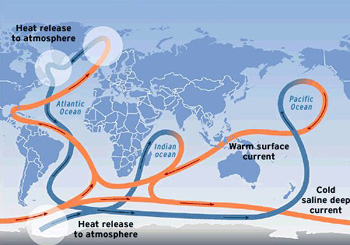At a time when the media is full of stories concerning global warming and the possibility of an ailing Gulf Stream plunging Western Europe into permafrost, US researchers have found that ocean circulation in the North Atlantic, which is thought to be closely linked to changes in the Earth’s climate, shut down abruptly about 17,500 years ago and then restarted almost as quickly.
The cause of the Gulf Stream shut down appears to have been natural climatic changes melting icebergs, which poured fresh water from the previously frozen North into the North Atlantic. The discovery could lend further evidence to the idea that global warming will wreak havoc on those Europeans currently basking in a temperate climate.

Beach scenes like this might become a thing of the past if the Gulf Stream shuts down (Credit: David Bradley)
Jerry McManus and colleagues R. Francois, Jeanne Gherardi, Lloyd Keigwin and Susan Brown-Leger at the Woods Hole Oceanographic Institution, Woods Hole, Massachusetts have analysed sediments in the Atlantic sea bed that were laid down about 20000 years ago. McManus and colleagues studied a sediment core from the subtropical North Atlantic from the Bermuda Rise area. The core contains the shells of foraminifera, shelled animals about the size of a sand grain, that can be used to reveal the surface water conditions when the animals were alive. The oxygen isotope ratio of the tiny grains of shell allowed the researchers to determine climatic changes that have occurred since the last ice age. They used a new technique that analyses two naturally occurring daughter isotopes of uranium, protactinium-231 and thorium-230, found in seawater, as a proxy for exposing the rate of ocean circulation.
The two isotopes are produced at constant rates in seawater by radioactive decay but quickly stick to particles, such as fragments of shell, in the water and settle to the ocean floor. Thorium is removed so rapidly by particles that it resides in the water column no more than a few decades before nearly all of it is buried on the sea floor. Protactinium lingers longer, staying in the water column for a century or two. This means that about half of the protactinium from North Atlantic waters reaches the Southern Ocean in today’s ocean circulation system – the great conveyor. When the overturning circulation slows, however, the proportion of buried protactinium rises in North Atlantic sediments.

Great Ocean Conveyor Belt (From the Intergovernmental Panel on Climate Change)
By comparing the ratio of the two isotopes in the sediment core using mass spectrometry, the team could produce, for the first time, a detailed time series showing the history of the strength of the ocean circulation.

Jerry McManus
At that time, glaciers covered a large proportion of the continents of the Northern Hemisphere. They reveal that the rate of the Atlantic Ocean’s north-south overturning circulation slowed dramatically and collapsed, when vast numbers of icebergs broke away from the ice shelves in the catastrophic Heinrich event H1 during the last deglaciation and huge flotillas drifted into the North Atlantic. The climate in this region rapidly became colder. The research also shows that when this ocean current (the Atlantic meridional circulation) started up very rapidly, northern Europe was exposed to strong regional warming. This suggests that the ocean circulation changed swiftly and dramatically at times of abrupt climate changes.
The change came quickly and lasted for two thousand years. Another cold snap occurred 12,700 years ago, McManus and his colleagues discovered, and this lasted more than a thousand years and accompanied another slowdown of overturning circulation. Each of these two cold intervals was followed by a rapid acceleration of the overturning circulation and dramatically warmer climates over Northern Europe and the North Atlantic region. The researchers cannot say whether the change occurred over decades or centuries but the limiting factor, McManus told Spotlight, is more likely to be the residence time of protactinium, which is of the order of two to three centuries. That’s the response, he adds, so the actual shutdown may have occurred much faster.
The Wood’s Hole findings strengthen evidence that the oceans and climate are intricately linked, and that rapid climate change may be related to how vigorously ocean currents transport heat from low to high latitudes. The results might be hailed as adding new credence to the dramatic climate change seen in the movie, The Day After Tomorrow and perhaps suggest that finding a space for one’s beach towel by the swimming pool may not be a priority for holidaymakers for much longer. McManus provides a chilling warning: Anything that has happened, can happen.
Further reading
Nature, 2004, 428, 834-837
http://dx.doi.org/10.1038/nature02494
Jerry McManus
http://www.whoi.edu/dept/profile.go?id=1561
Suggested searches
climate change
ocean circulation